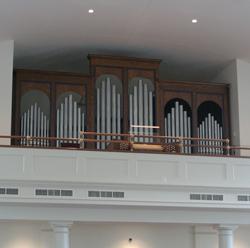
Buzard Pipe Organ Builders announces the upcoming re-dedication concert of the recently rebuilt, revoiced and relocated Robert Noehren organ of 1963 at Holy Spirit Lutheran Church, 3075 Bees Ferry Road, Charleston, South Carolina. The program will be given on Sunday, February 12 at 4:00 in the afternoon, and will be played by Stephen Buzard, Music Director of the Cathedral of St. James, Chicago.
The organ was originally located in the rear gallery of the nave of the former St. Richard of Chicester Episcopal Church, the gift of the late Edward Charles Flinn. It was built by Robert Noehren of Ann Arbor, Michigan. The original three-manual, drawknob console of walnut is of a low-profile design. The Great and Positiv divisions are duplexed and were originally on one large chest. Wind pressure is 2-1/2”. Manual compass is 56 notes (C–G); Pedal compass is 32 (C–G). Noehren played identical dedicatory recitals on the afternoon and evening of December 29, 1963. He would return to make a recording of the music of François Couperin on this organ. Originally equipped with a combination setter board, the console has since been outfitted with a multiple-memory solid state combination action. Also, a 5-bell Zimbelstern and 32’ Resultant were added in 1988.
The instrument was removed from the church and taken back to the Buzard organ factory. There it was cleaned and re-regulated. The console was refurbished and all of the electro-mechanical actions were replaced. Pipe repairs and replacements, as well as complete tonal re-engineering, was accomplished by Tonal Director Brian Davis and his staff. The new installation at Holy Spirit Lutheran Church in Charleston, South Carolina, and features a new façade and several ranks of new pipework.
For information: buzardorgans.com.

